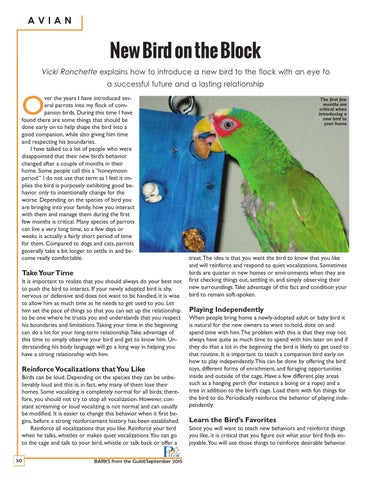AVIAN
New Bird on the Block
Vicki Ronchette explains how to introduce a new bird to the flock with an eye to
O
a successful future and a lasting relationship
ver the years I have introduced several parrots into my flock of companion birds. During this time I have found there are some things that should be done early on to help shape the bird into a good companion, while also giving him time and respecting his boundaries. I have talked to a lot of people who were disappointed that their new bird’s behavior changed after a couple of months in their home. Some people call this a “honeymoon period.” I do not use that term as I feel it implies the bird is purposely exhibiting good behavior only to intentionally change for the worse. Depending on the species of bird you are bringing into your family, how you interact with them and manage them during the first few months is critical. Many species of parrots can live a very long time, so a few days or weeks is actually a fairly short period of time for them. Compared to dogs and cats, parrots generally take a bit longer to settle in and become really comfortable.
Take Your Time
It is important to realize that you should always do your best not to push the bird to interact. If your newly adopted bird is shy, nervous or defensive and does not want to be handled, it is wise to allow him as much time as he needs to get used to you. Let him set the pace of things so that you can set up the relationship to be one where he trusts you and understands that you respect his boundaries and limitations. Taking your time in the beginning can do a lot for your long-term relationship. Take advantage of this time to simply observe your bird and get to know him. Understanding his body language will go a long way in helping you have a strong relationship with him.
Reinforce Vocalizations that You Like
Birds can be loud. Depending on the species they can be unbelievably loud and this is, in fact, why many of them lose their homes. Some vocalizing is completely normal for all birds; therefore, you should not try to stop all vocalization. However, constant screaming or loud vocalizing is not normal and can usually be modified. It is easier to change this behavior when it first begins, before a strong reinforcement history has been established. Reinforce all vocalizations that you like. Reinforce your bird when he talks, whistles or makes quiet vocalizations.You can go to the cage and talk to your bird, whistle or talk back or offer a 50
BARKS from the Guild/September 2015
The first few months are critical when introducing a new bird to your home
treat. The idea is that you want the bird to know that you like and will reinforce and respond to quiet vocalizations. Sometimes birds are quieter in new homes or environments when they are first checking things out, settling in, and simply observing their new surroundings. Take advantage of this fact and condition your bird to remain soft-spoken.
Playing Independently
When people bring home a newly-adopted adult or baby bird it is natural for the new owners to want to hold, dote on and spend time with him. The problem with this is that they may not always have quite as much time to spend with him later on and if they do that a lot in the beginning the bird is likely to get used to that routine. It is important to teach a companion bird early on how to play independently. This can be done by offering the bird toys, different forms of enrichment, and foraging opportunities inside and outside of the cage. Have a few different play areas such as a hanging perch (for instance a boing or a rope) and a tree in addition to the bird’s cage. Load them with fun things for the bird to do. Periodically reinforce the behavior of playing independently.
Learn the BirdÊs Favorites
Since you will want to teach new behaviors and reinforce things you like, it is critical that you figure out what your bird finds enjoyable.You will use those things to reinforce desirable behavior.
